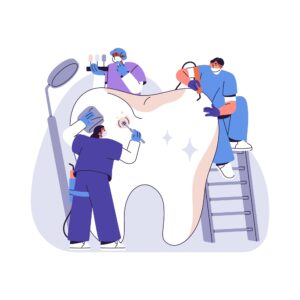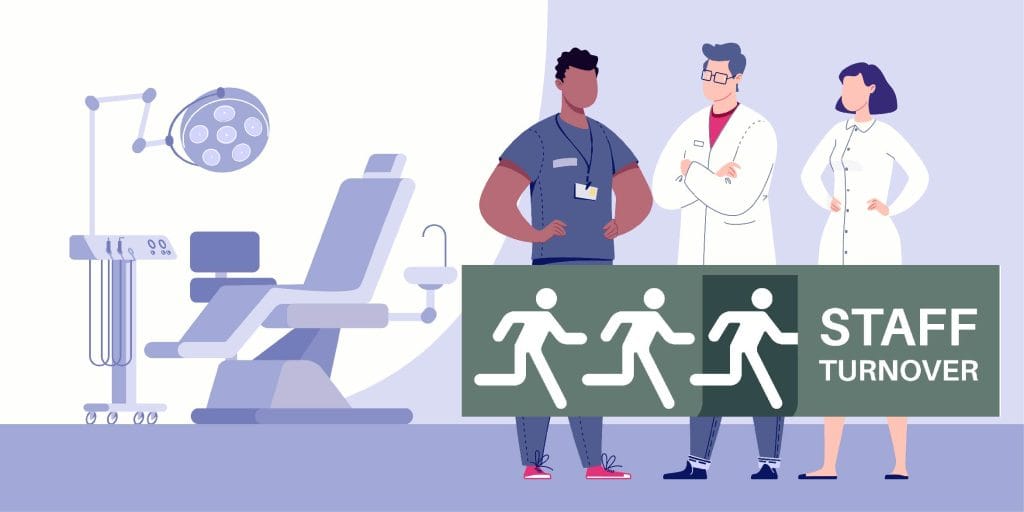 When many dental practices implement new case acceptance techniques, they often focus solely on new patients. But here’s the kicker—over 60% of your monthly revenue should come from the patients who already know and trust you.
When many dental practices implement new case acceptance techniques, they often focus solely on new patients. But here’s the kicker—over 60% of your monthly revenue should come from the patients who already know and trust you.
At MGE, a common misconception occurs when we begin to train a new client on case acceptance strategies (for example at the MGE Communication and Sales Seminars). These new clients often believe these techniques are only applicable to new patients. They assume that their patients of record wouldn’t respond to this new way of operating and assume they should focus on presenting their “new self” and revamped techniques solely to the new faces walking into their practice. And look – I understand, this logic makes sense at first glance, but…it’s flawed—and when we clarify this issue – things really begin to take off.
Here’s a fact: Over 60% of your monthly revenue should be coming from your patients of record, the ones who already know you and trust you. You already have a relationship with these folks and many of them have treatment you’ve already diagnosed (see your incomplete treatment list) and they have yet to follow through. Not capitalizing on these opportunities is not only lowering your office’s revenue potential – it – more importantly isn’t helping these patients become healthier!
The Power of Patients of Record: Why New Patients Aren’t Your Only Source of Growth
If you were to ask the average dentist what they’d need to increase collections – 9 out of 10 would probably say “more new patients.” And to a degree they are correct – new patients are indeed important, but again, they shouldn’t be your sole focus. The majority of your practice’s revenue should actually be coming from patients who are already in your system, and I don’t mean your hygiene program! Yes, this should be a profit center – but most of your collections should be coming from patients that currently reside on your incomplete treatment list.
To make a point – you could take a quick break from reading this article and have a look at this list. Look at how much treatment that’s been diagnosed over the past two, three or even five years. Chances are your software will total this report. What’s the number? For many, this is at least several hundred thousand dollars – or a million – I’ve seen these lists in the millions.
So why aren’t these patients completing their treatment? Well, let’s be real – they weren’t “closed” on doing the treatment. Sure, in some cases it might also be a matter of poor follow up – but for the majority, there was some barrier that you or your team members couldn’t overcome. And to that end, with a little bit of training on the subject of treatment presentation, it’s a common thing at MGE to see a client experience significant increases in revenue simply by re-engaging these patients. For example, clients who attend our MGE Communication and Sales Seminars often see a sharp increase in revenue the week/month after the seminar? Well, where did that come from? The marketing they learned a week or two earlier at the MGE New Patient Workshop hadn’t even had a chance to kick in yet. So, it was from the same traffic (patients of record and new patients) that they had before they came to MGE. Except now – they were getting patients to say yes. Patients now wanted the treatment they needed. That patient who said “let me think about it” to three inlays and an onlay, now says “yes” with these improved communication techniques. And this just gets better as more inactive patients are driven into the practice and new patients are acquired.
When You Assume, You Make an A#@ out of You and Me!
 A common reason for this missed opportunity with patients of record is “assumptions.” We assume that because a patient declined treatment last time, they won’t accept it later. This preconceived notion is a major barrier to closing more cases. I’ve even seen it where a patient declined treatment at their last recall and the office doesn’t even bother to talk about it with them again!
A common reason for this missed opportunity with patients of record is “assumptions.” We assume that because a patient declined treatment last time, they won’t accept it later. This preconceived notion is a major barrier to closing more cases. I’ve even seen it where a patient declined treatment at their last recall and the office doesn’t even bother to talk about it with them again!
Give you an example, we had a client whose office manager assumed a patient, a janitor at a local hospital, couldn’t afford a $3,000 treatment plan. The reason? She had financed a larger treatment plan the previous year and the office manager assumed she was still paying that off. We happened to be on site at the time. The Office Manager (and doctor) hadn’t planned to even discuss this with the patient due to this assumption. In any event, using the old “you miss 100% of the shots you don’t take,” motivational lines, they decided to discuss it with the patient. And guess what? The patient accepted it without hesitation.
This is an important lesson: You can’t know what a patient is thinking or capable of financially unless you ask. And often, the answer will surprise you. And again, we’re not talking about a widget or a piece of furniture or a new smart phone. We’re talking about a patient’s health. Which only makes this discussion all the more important!
Repetition Breeds Success: Why You Should Re-Present Treatment Plans
Patients don’t always accept treatment the first time they hear about it. But that doesn’t mean they won’t accept it later. Think about how many times you’ve seen a commercial before you decided to make a purchase. Repetition is key in marketing, and this carries over (without being annoying or ridiculous of course) to sales.
Just about every dentist has had the experience of presenting a treatment plan that the patient declines only for the patient to come back months later and say, “You know, I’m ready to go ahead with that treatment we discussed last time.” Sometimes it just takes a few visits, or a change in circumstances, for patients to come around.
This is why it’s so important not to give up on presenting treatment to patients who initially said “no.” Maybe their financial situation has improved, or maybe they had a recent health scare that made them reconsider the importance of their dental care. Whatever the reason, if you don’t ask, you’ll never know.
Structuring Your Schedule for Success: The Importance of Setting Aside Time for Case Presentations
A big reason (beyond poor sales techniques) that practices fail to close treatment plans is simply a lack of time. If you’re running from one patient to the next, there’s rarely enough time to properly present a case—especially if the patient needs a more extensive treatment plan.
This is why it’s essential to bake time into your schedule for case presentations. This shouldn’t just be reserved for new patients; you need to make time for presenting treatment plans to existing patients as well.
 If a patient comes in for a hygiene appointment and outstanding treatment, but you’re too busy to fully explain the case when you’re doing your recall exam, take a moment to schedule a follow-up consultation. Tell them you’ve identified areas of concern and want to take 20 minutes in the next day or two to fully explain the situation and go over the options. This ensures they get your undivided attention and increases the likelihood of case acceptance.
If a patient comes in for a hygiene appointment and outstanding treatment, but you’re too busy to fully explain the case when you’re doing your recall exam, take a moment to schedule a follow-up consultation. Tell them you’ve identified areas of concern and want to take 20 minutes in the next day or two to fully explain the situation and go over the options. This ensures they get your undivided attention and increases the likelihood of case acceptance.
If you don’t have time to close the case, don’t start the presentation. It’s actually better to schedule a proper consultation than to rush through it and leave the patient unsure.
Morning Production Meetings: The Secret to Predictable Revenue
A Morning Production Meeting is an essential tool for practices that want to stay on top of case presentations and revenue. (a handout on how to properly run one of these meetings can be found by clicking here). This meeting allows your team to review the day’s schedule and identify patients with outstanding treatment plans. By discussing these patients each morning, you can strategize who will present the treatment, how it will be presented, and ensure that you have time to properly explain the necessary care.
During these meetings, you’ll also want to look at the total value of treatment coming through your door that day. If you see that $26,000 of potential treatment is on the hygiene (or doctor’s) schedule, you can strategize to close half of that and be on track for your monthly revenue goal. Having a concrete number helps you stay on top of your collections and ensures your practice runs predictably.
Activating Your Patient Base: Don’t Forget the Power of Hygiene
In some cases, your hygiene schedule may look “clean,” with no outstanding treatments to present. If this happens regularly, it could indicate a larger issue—namely, that you’re not keeping enough of your patient base active.
The patients who show up consistently for hygiene appointments are often the ones who have already completed their treatment plans. If you have a ton of inactive patients, with little follow up, the only ones that “stick” on the hygiene schedule are the ones who are most compliant. You know what I mean, the patient whose hygiene appointment you had to cancel who then chases YOU to reschedule. Well, these are your top tier patients from a compliance perspective. And that’s great, but they are FAR from the average patient. The average patient (the majority) needs follow up. Without that follow up, they drift off and become inactive. Hygiene stops growing. And then you look and see that the 800 patients who are staying regular on your hygiene schedule are “clean” and they have no outstanding treatment. The only apparent solution is “new patients.” Which again, you should get, but what you’re not looking at is the 3,000 patients that you’ve allowed to go inactive! These are often the patients who need the most work, but without consistent follow-up and reactivation efforts, they fall through the cracks.
majority) needs follow up. Without that follow up, they drift off and become inactive. Hygiene stops growing. And then you look and see that the 800 patients who are staying regular on your hygiene schedule are “clean” and they have no outstanding treatment. The only apparent solution is “new patients.” Which again, you should get, but what you’re not looking at is the 3,000 patients that you’ve allowed to go inactive! These are often the patients who need the most work, but without consistent follow-up and reactivation efforts, they fall through the cracks.
If you’re not actively following up with these patients and working to get them back on your schedule, you’re missing out on both revenue and the chance to improve their health.
Conclusion: The Win-Win of Recapturing Missed Treatment Opportunities
Focusing on case presentations to existing patients isn’t just a revenue strategy—it’s about improving patient health. The more patients you get to say “yes” to their full treatment plans, the healthier they’ll be, and the more your practice will thrive.
By avoiding assumptions, creating time for case presentations, staying on top of everyone in your patient base to keep them active, and ensuring that your team is organized with morning production meetings, you’ll see a significant improvement in both your patients’ health and your practice’s bottom line.
Again, if you want to master this subject, I highly recommend attending the MGE Communication & Sales Seminars.
Hope this helps! And have a great week!



No Comments
Be the first to start a conversation